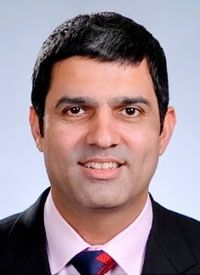Expert Discusses Obstacles Facing Non-Driver Lung Adenocarcinoma
Mohammad Jahanzeb, MD, discusses why researchers must work on identifying targetable mutations in these non-driver adenocarcinomas and shares his insight on other trends and challenges in the field.
Mohammad Jahanzeb, MD

Mohammad Jahanzeb, MD
Patients with nonsmall cell lung cancer (NSCLC) undergo molecular testing to determine what genetic abnormalities are present. If a common-enough mutation is detectedsuch asEGFRorALKthen patients are able to receive a targeted agent matched to that driver.
However, for patients with non-drivermutated lung adenocarcinoma, options have been limited for more than 3 decades, explains Mohammad Jahanzeb, MD.
“In other words, it’s the ‘non-fun’ stuff,” said Jahanzeb. “It does not include any new mutations, immunotherapy, anti-VEGF antibodies, or any other antibodies. Basically, this is the platinum-based doublet therapy that we have had for more than 3 decades.”
There are still multiple areas in which chemotherapy can be used in these patients, he adds, including in the first- and second-line settings and as maintenance therapy. Moreover, researchers are comparing cisplatin- versus carboplatin-based regimens, and exploring new options for maintenance treatment.
For example, an ongoing, double-blind, randomized trial is investigating the differences in efficacy and safety between erlotinib (Tarceva) and pemetrexed as maintenance therapy in patients with lung adenocarcinoma (NCT02399566).
A second study is exploring bevacizumab (Avastin) as a maintenance treatment for patients with lung adenocarcinoma who previously received 4 to 6 cycles of induction platinum-based doublet therapy plus bevacizumab (NCT02093000).
In an interview withTargeted Oncology, Jahanzeb, who is professor of Clinical Medicine, Hematology/Oncology, Sylvester Comprehensive Cancer Center, University of Miami Miller School of Medicine, discussed why researchers must work on identifying targetable mutations in these non-driver adenocarcinomas and shared his insight on other trends and challenges in the field.
TARGETED ONCOLOGY:This sounds like a difficult subtype of lung cancer to treat. What should community oncologists take away from your presentation?
Jahanzeb:
They should keep [working to] shrink the non-driver mutation adenocarcinoma population. We should test everyone, and there should be no such thing [as non-driver adenocarcinoma]. Everybody should get individualized and personalized treatment.
TARGETED ONCOLOGY:What treatment changes do you see occurring in this area over the next decade?
Jahanzeb:
It is very excitingWorld War II is where, by accident, we saw nitrogen mustard as chemotherapy. Sixty-five years later, by 2010, we still only had less than 10 FDA-approved drugs for lung cancer. In the last 5 years, we have had more than 10 drugs approved for the disease. Today, there are 600 to 700 drugs in the pipeline.
What we will see now is more and more targeted therapies, many lines of therapy, combinations of immunotherapy agents with targeted therapies, and combinations of checkpoint inhibitors with each other. We will be shrinking the diminishing role of cytotoxic chemotherapy, so it’s a very exciting time.
TARGETED ONCOLOGY:What combination regimens are currently being studied that could be practice changing?
Jahanzeb:
I am very excited about the checkpoint inhibitor combinations, such as ipilimumab (Yervoy) and nivolumab (Opdivo). There are many examples of multiple checkpoint inhibitor clinical trials. I am also very interested in targeted therapy combination trials to inhibit multiple points in the pathway, as well as inhibit multiple pathways that can cooperate with each other. Those are very exciting explorations that are going on right now.
TARGETED ONCOLOGY:Aside from this population having limited treatment options, what other obstacles are there?
Jahanzeb:
One of the major challenges is that there are too many trials that are competing with each other. Also, there is still not enough tissue testing.
And, community radiation oncologists, medical oncologists, interventional radiologists, and pathologists need to all be sitting in 1 roomrather than be making these decisions in isolation. Universities and institutions may have tumor boards, but there needs to be a tumor board available for every practice. We are at that point now.
TARGETED ONCOLOGY:You mentioned there being too many ongoing clinical trials. How can the oncology community overcome that?
Jahanzeb: